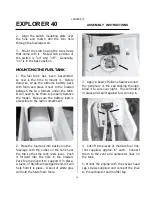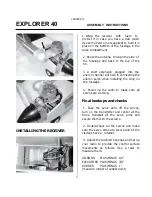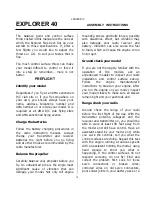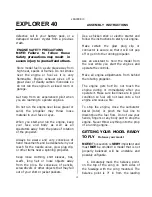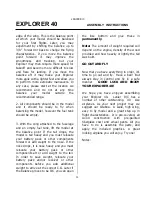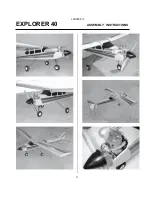
LANIER R/C
EXPLORER 40
ASSEMBLY
INSTRUCTIONS
19
defective cell in your battery pack, or a
damaged receiver crystal from a previous
crash.
ENGINE SAFETY PRECAUTIONS
NOTE: Failure to follow these
Safety precautions may result in
severe injury to yourself and others.
Store model fuel in a safe place away from
high heat, sparks or flames. Do not smoke
near the engine or fuel as it is very
flammable. Engine exhaust gives off a
great deal of deadly carbon monoxide so
do not run the engine in a closed room or
garage.
Get help from an experienced pilot when
you are learning to operate engines.
Do not run the engine near loose gravel or
sand; the propeller may throw loose
material in your face or eyes.
When you start and run the engine, keep
your face and body as well as all
spectators away from the plane of rotation
of the propeller.
Always be aware and very conscious of
hand movements and be deliberate in your
reach for the needle valve, glow plug clip,
or other items near a spinning propeller.
Keep loose clothing, shirt sleeves, ties,
scarfs, long hair or loose objects away
from the prop. Be conscious of pencils,
screwdrivers or other objects that may fall
out of your shirt or jacket pockets.
Use a chicken stick or electric starter and
follow the instructions to start your engine.
Make certain the glow plug clip or
connector is secure so that it will not pop
off or get into the running propeller.
Ask an assistant to hold the model from
the rear while you start the engines and
operate the controls.
Make all engine adjustments from behind
the rotating propeller.
The engine gets hot! Do not touch the
engine during or immediately after you
operate it. Make sure fuel lines are in good
condition so fuel will not leak onto a hot
engine and cause a fire.
To stop the engine, close the carburetor
barrel (rotor) or pinch the fuel line to
discontinue the fuel flow. Do not use your
hands, fingers or any body part to stop the
engine. Never throw anything into the prop
of a running engine.
GETTING YOUR MODEL READY
TO FLY
Balance your model
NOTE:
This section is
VERY
important and
must
NOT
be omitted! A model that is not
properly balanced will be unstable and
possibly unflyable.
1. Accurately mark the balance point
on the top of the wing on both sides of
the fuselage with the wing mounted. The
balance point is 3” in from the leading












